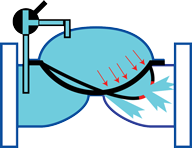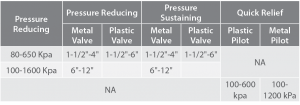
how to use:
We have a valve for almost any application. Basic, manual operation, pressure reducing, pressure sustaining, pressure reducing & sustaining, back-flush, electric activation, plastic, metal, quick relief… Wow!
Use with :
Need a pilot, solenoid, bit of hose? Our Valve Accessories section has everything you need
I’ve got a feeling that our valves are going to turn you on…(pun totally intended)
Here’s why: Our valves use a piston mechanism instead of a weir diaphragm. What!? You are saying. No idea what you mean.
Let me explain. A competitor ‘weir’ style diaphragm would look a bit like this inside
The diaphragm is round causing uneven pressure across the diaphragm when closed. What’s wrong with this? The diaphragm can stress and distort. This can lead to leaks and ruptures.
Once the diaphragm is distorted, it won’t easily open correctly causing higher head loss.
Now take a look at a Rivulis globe valve:
A totally different shaped diaphragm, but more importantly all forces on the diaphragm are consistent and in one direction. This makes it hard for the diaphragm to bend and become damaged or rupture.
We do apologise that if you buy our valves, you won’t need to buy replacement diaphragms all the time. But we think this is a good thing.!
Also did you know…
Due to the design of the valves, there is only one diaphragm and one spring. Our valves operate at wide pressure ranges removing the need for different diaphragms and springs for different applications. In other words, less models = less headaches.
Control Valve Data
Valve Functions
Basic Valves: Valve body, nothing more, nothing less
3 Way Manual Valves: Valve body with a manual selector so you can manually open and close your valve
Electric Control: Control your valve opening through automation.
Pressure Reducing (PR): Got too much pressure. A pressure reducing valve will do exactly as it promises. It will reduce the pressure to the level set by the pilot.
Pressure Sustaining (PS): Sometimes you need a bit of resistance for irrigation components to work correctly. A pressure sustaining valve will keep the pressure before the valve at a preset amount. Very helpful after a filter to ensure effective backwashing pressure to clean automatic filters
PR & PS: Get both pressure reducing and pressure sustaining in one valve
Quick Relief: Relieves system pressure when pressure rises above a preset value
Back-Flush: As the name suggests, this is the valve you want on your media filter back-flush mechanism








































